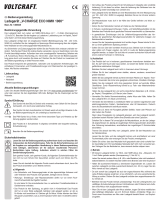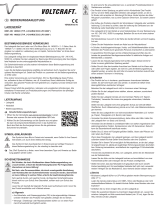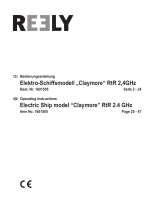Page is loading ...

35
TABLE OF CONTENTS
Page
1. Introduction .........................................................................................................................36
2. Intended use .......................................................................................................................37
3. Deliverycontent ..................................................................................................................37
4. Features and functions .......................................................................................................38
5. Explanation of symbols .......................................................................................................38
6. Safety instructions ..............................................................................................................39
7. Notes on rechargeable batteries ........................................................................................41
a) General information ........................................................................................................41
b) Additional information on lithium batteries .....................................................................43
8. Safety notes on battery charging ........................................................................................45
9. Operating elements ............................................................................................................48
10. Menu structure ....................................................................................................................49
11. Operating the menus ..........................................................................................................50
12. Charging batteries ..............................................................................................................51
13. Checking inforamtion during charging ................................................................................54
14. Charging modes .................................................................................................................55
15. Programming presets .........................................................................................................56
a) Setting up a preset .........................................................................................................56
b) Recalling a preset ..........................................................................................................58
16. System setting ....................................................................................................................58
17. Battery measuring ..............................................................................................................61
18. Battery resistance measuring .............................................................................................62
19. Warning and error messages .............................................................................................63
20. Using the software Charge Master .....................................................................................64
21. Maintenace and cleaning ....................................................................................................65
22. Disposal ..............................................................................................................................65
a) Product ...........................................................................................................................65
b) (Rechargeable)batteries ................................................................................................65
23. Technical data .....................................................................................................................66

36
1. INTRODUCTION
Dear Customer,
In purchasing this Voltcraft
®
product,youhavemadeaverygooddecisionforwhichwewould
like to thank you.
Voltcraft
®
-Intheeldofmeasuring,chargingandnetworktechnology,thisnamestandsfor
high-quality products which perform superbly and which are created by experts whose concern
iscontinuousinnovation.
From the ambitious hobby electronics enthusiast to the professional user, products from the
Voltcraft
®
brandfamilyprovidetheoptimumsolutionevenforthemostdemandingtasks.Andthe
remarkable feature is: we offer you the mature technology and reliable quality of our Voltcraft
®
products at an almost unbeatable price-performance ratio. In this way, we aim to establish a
long, fruitful and successful co-operation with our customers.
We wish you a great deal of enjoyment with your new Voltcraft
®
product!
Allcompanynamesandproductnamesaretrademarksoftheirrespectiveowners.Allrights
reserved.
If there are any technical questions, please contact:
International: www.conrad.com/contact
United Kingdom: www.conrad-electronic.co.uk/contact

37
2. INTENDED USE
ThechargerisusedtochargeNiCd+NiMHtyperechargeablebatteries(1-15cells),LiPo/
LiIon/LiFebatteries(1-6cells)andleadacidbatteries(2V-20V).Thechargecurrentcan
be set between 0.1 A and 6.0 A depending on the connected batteries and their cell number/
capacity.
Batteriescanalsobedischarged;thedischargecurrentisbetween0.1to2.0A.
ThechargercanbeconnecteddirectlytoACpower(100–240V/AC,50/60Hz)ortoastabilised
direct current between 11 V/DC and 18 V/DC.
A two-line illuminated LC display and four keys are used to control the charger.
A balancer is integrated into the charger for LiPo/LiIon/LiFe batteries, with balancer connector
sockets for the battery located on the right side of the charger.
It is intended for indoor use only. Do not use it outdoors. Contact with moisture, e.g. in bathrooms,
mustbeavoidedunderallcircumstances.
Forsafetyandapprovalpurposes(CE),youmustnotrebuildand/ormodifythisproduct.Ifyou
usetheproductforpurposesotherthanthosedescribedabove,theproductmaybedamaged.
Inaddition,improperusecancausehazardssuchasshortcircuiting,re,electricshocketc.
Readtheinstructionscarefullyandkeepthem.Makethisproductavailabletothirdpartiesonly
together with its operating instructions.
This product complies with the statutory national and European requirements.
3. DELIVERY CONTENT
• Multi-charger
• Power cable
• Connection cable with alligator clips
• 5xchargingcables(Tplug/alligatorclips/Futabaplug/JSTplug/XT60plug)
• Software CD
• Operating instructions

38
4. FEATURES AND FUNCTIONS
• Built-in power adapter
• Cell recognition
• Automatic and time-related settings for charging limits
• Inputvoltagemonitoring
• PC link socket
• Lithium battery measuring
• Internal resistance measuring
• Re-peak mode for NiMH/NiCd rechargeable batteries
• Adjustablenaldischargevoltage
• 3-pin connector for temperature probe
5. EXPLANATION OF SYMBOLS
This symbol indicates a health hazard, e.g. electric shock.
Theexclamationmarkindicatesspecicrisksassociatedwithhandling,functionand
use.
The “arrow” symbol indicates special tips and operating information.

39
6. SAFETY INSTRUCTIONS
Read the operating instructions carefully and especially observe the safety
information. If you do not follow the safety instructions and information
on proper handling in this manual, we assume no liability for any resulting
personal injury or damage to property. Such cases will invalidate the warranty/
guarantee.
a) Persons / Product
• Thedeviceisnotatoy.Keepitoutofthereachofchildrenandpets.
• Donotleavepackagingmateriallyingaroundcarelessly.Thesemaybecome
dangerous playing material for children.
• Protect the product from extreme temperatures, direct sunlight, strong jolts, high
humidity,moisture,ammablegases,vapoursandsolvents.
• Do not place the product under any mechanical stress.
• If it is no longer possible to operate the product safely, take it out of operation and
protect it from any accidental use. Safe operation can no longer be guaranteed
if the product:
- isvisiblydamaged,
- is no longer working properly,
- has been stored for extended periods in poor ambient conditions or
- has been subjected to any serious transport-related stresses.
• Pleasehandletheproductcarefully.Jolts,impactsorafallevenfromalowheight
can damage the product.
• Alsoobservethesafetyandoperatinginstructionsofanyotherdeviceswhichare
connected to the product.
• Donotexposethedevicetodirectsunlight,hightemperatures(>35°C)or
extremecold(<0°C).Keepitawayfromdustanddirt.Thesameappliestoany
battery that may be connected.
• The product is not a toy. It is not suitable for children. Pay particular attention
when children are present!
• The product may only be set up, used or stored in places that are not accessible
to children. Children may change the settings or short-circuit the battery/battery
pack which can lead to an explosion. Danger to life!

40
• Donotusethebatterychargerinsideavehicle.
• Donotplaceanycontainerslledwithliquid,e.g.vasesorplants,onornextto
the charger.
When these liquids get into the charger, the charger will be destroyed and there
isaconsiderablerehazard.
If this occurs, immediately disconnect the product from the power supply, then
disconnect the battery from the charger. Do not use the charger again - bring it to
a specialist workshop.
• Onlyoperatetheproductinmoderateclimate,neverintropicalclimate.Formore
informationonacceptableenvironmentalconditions,seethechapter“Technical
Data”.
• Chooseasolid,at,cleanandsufcientlylargesurfaceforthebatterycharger
and the battery.
Neverplacethebatterychargerandthebatteryonaammablesurface(e.g.
carpet).Alwaysuseasuitable,non-ammable,heatproofsurface.
• Ensurethatthereissufcientventilationduringoperation.Nevercoverthe
batterychargerand/ortheconnectedbattery.Leaveenoughdistance(atleast20
cm) between the charger, the battery and other objects.
• Neveroperatethedeviceimmediatelyafterithasbeentakenfromacoldroomto
a warm room. Under certain circumstances the resulting condensation may lead
to malfunctions or damage!
Allowthecharger(andthebattery/batteries)toreachroomtemperaturebefore
connectingthechargertothepowersupplyandusingit.Thismaytakeseveral
hours!
• Maintenance, adjustments and repair work may only be carried out by a
specialist/specialisedworkshop.Thedevicecontainsnopartsthatrequire
servicingoradjusting.
• If the product is used at schools, training facilities, do-it-yourself or hobby
workshops,ithastobesupervisedbytrainedpersonnel.

41
• Donotleavepackagingmateriallyingaroundcarelessly.Itmightbecomea
dangerous toy for children!
• Handle the product with care. It can be damaged by impact, blows or when
droppedevenfromalowheight.
b) Miscellaneous
• Consult an expert when in doubt about operation, safety or connection of the
device.
• Maintenance,modicationsandrepairsaretobeperformedexclusivelybyan
expertorataqualiedshop.
• Ifyouhavequestionswhichremainunansweredbytheseoperatinginstructions,
contactourtechnicalsupportserviceorothertechnicalpersonnel.
7. NOTES ON RECHARGEABLE BATTERIES
Despitethefactthatbatteries,bothrechargeableandnon-rechargeable,havebecomeanormal
partoftoday’slife,therearestillnumerousdangersandproblemsinvolved.Inparticular,with
LiPo/LiIon/LiFe rechargeable batteries with their high energy content (in comparison with
conventionalNiCdorNiMHrechargeablebatteries),variousregulationsmustbeobservedin
ordertoavoidthedangerofexplosionandre.
Forthisreason,alwaysensurethatyouhavereadandunderstoodthefollowinginformationand
safety measures when handling batteries.
If there is any other information included with the battery, it also has to be read
throughcarefullyandobserved!
a) General information
• Rechargeable batteries are no toys. Always keep batteries out of the reach of
children.
• Donotleaverechargeablebatterieslyingaroundopenly.Childrenorpetsmay
swallow them. If swallowed, consult a doctor immediately!
• Rechargeable batteries must not be short-circuited, taken apart or thrown into
re.Thereisariskofreandexplosion!
• Leaking or damaged rechargeable batteries may cause caustic burns if they
comeintocontactwithskin.Thereforeyoushouldusesuitableprotectivegloves
for this.

42
• Donotrechargenormal,non-rechargeablebatteries.Thereisariskofreand
explosion!
• Non-rechargeable batteries are meant to be used once only and must be
disposed of properly when empty.
• Only charge rechargeable batteries that are intended for that purpose and use a
suitable battery charger.
• Batteries must not get damp or wet.
• Neverleavethecharging/dischargingbatteriesunattended.
• Pleaseobservecorrectpolarity(plus/+andminus/-)whenconnectingthe
rechargeable battery to your model or charger. Connecting the battery incorrectly
willnotonlydamagethemodelbutalsothebattery.Thereisariskofreand
explosion!
This charger has a mechanism that protects against connecting the poles
incorrectly. Nonetheless, it is possible that an incorrectly connected battery may
lead to damage in certain situations.
• Iftheproductisnottobeusedforalongperiodoftime(e.g.storage),disconnect
any connected battery from the charger and disconnect the charger from the
power supply.
• Donotcharge/dischargeanybatterythatisstillhot(e.g.causedbyhigh
discharge current from the model) Allow the battery to cool down to room
temperature before attempting to charge or discharge it.
• Nevercharge/dischargedamaged,leakingordeformedbatteries.Thiscanresult
inareorexplosion!Disposeofanyunusablerechargeablebatteriesinan
environmentallycompatiblefashion.Donotcontinuetousethem.
• Neverusebatterypacksthatarecomposedofdifferenttypesofcells.
• Rechargetherechargeablebatteriesaboutevery3months,becauseotherwise
there may be a total discharge due to self-discharge, which makes the
rechargeable batteries useless.
• Removethebatteryfromthechargerwhenitisfullycharged.
• Neverdamagetheexteriorcoverofabattery.Thereisariskofreandexplosion!
• Nevercharge/dischargeabatterydirectlyinthemodel.Removethebatteryfrom
themodelrst.

43
• Placethechargerandbatteryonanon-ammable,heat-resistantsurface(e.g.
stonetiles).Maintainenoughdistancefromammableobjects.Allowenough
distancebetweenthechargerandthebattery-neverplacethebatteryonthe
charger.
• As both the charger and the battery heat up during the charge/discharge
procedure,itisnecessarytoensuresufcientventilation.Nevercoverthe
charger or the battery!
b) Additional information on lithium batteries
ModernbatterieswithlithiumtechnologydonotonlyhaveaclearlyhighercapacitythanNiMH
orNiCdrechargeablebatterypacksbuttheyalsohaveaconsiderablylowerweight.Thismakes
thistypeofbatteryveryinterestingforapplicationinmodelconstruction;socalledLiPobatteries
(lithium-polymer)areoftenusedhere.
LiPobatteries(andtheLiFeandLiIonbatteriesthatcanbechargedwiththedevice)dorequire
specialcarehoweverduringcharging/dischargingaswellaswhenbeingoperatedandhandled.
For this reason, we would like to provide you with some information in the sections below
aboutthedangersandhowyoucanavoidthem,thushelpingsuchbatteriestomaintaintheir
performance for a long time to come.
See also chapter 7. a)
• TheexteriorcoveringofaLiPobattery,usuallyconsistingsolelyofaverythick
lm,isextremelysensitive.
Neverdestroyordamagethebattery,neverletthebatteryfall,donotpiercethe
batterywithanyobjects.Avoidapplyinganymechanicalloadstothebattery,
neverpullonthebattery’sconnectorcables!Thereisariskofreandexplosion!
Theseguidelinesmustalsobeobservedwhenthebatteryisinsertedintothe
model(orremovedfromthemodel)
• Ensurethatthebatterydoesnotoverheatduringusage,recharging,discharging,
transportorstorage.Donotplacethebatterynexttosourcesofheat(e.g.cruise
control,motor),keepthebatteryawayfromdirectsunlight.Thereisariskofre
andexplosionifthebatteryoverheats!
Thebatterymustnotreachatemperatureofmorethan60°C(anyother
manufacturer warnings must also be heeded as applicable!).

44
• Ifthebatteryisdamaged(e.g.afteranairplaneorhelicoptermodelcrashes)or
theexteriorshellisinated/swollen,donotcontinuetousethebattery.Donot
rechargeit.Thereisariskofreandexplosion!
Handlethebatterywithcare,usesuitableprotectivegloves.Disposeofthe
battery in an ecologically sound fashion.
• Only use a suitable charger to charge lithium batteries or use the correct charging
procedure.Duetoariskofreandexplosion,conventionalchargersforNiCd,
NiMH and lead acid batteries may not be used!
• When charging a lithium battery with more than one cell, always use a so-called
“balancer”(oneisalreadyintegratedintothesuppliedcharger).
ChargeLiPobatterieswithamax.chargecurrentof1C(ifnotindicated
otherwise by the battery manufacturer!). This means that the charge current may
notexceedthecapacityvalueimprintedonthebattery(e.g.batterycapacity1000
mAh, max. charge current 1000 mA = 1 A).
WithLiFeorLiIonbatteries,youmustobservetheinstructionsofthebattery
manufacturer.
• Thedischargecurrentmustnotexceedthevaluedisplayedonthebattery.
Forexample,ifavalueof“20C”isprintedonthebattery,themax.discharge
currentis20timesthebattery’scapacity(e.g.batterycapacity1000mAh,max.
discharge current 20 C = 20 x 1000 mA = 20 A).
Iftheseguidelinesarenotadheredto,thebatterywilloverheat,whichwillleadto
thebatterybecomingdeformed/swollenorresultinanexplosionandre!
Theprintedvalue(e.g.“20C”)doesnotgenerallyrefertotheconstantcurrent,
but to the maximum current that the battery is capable of producing in the short-
term.Theconstantcurrentshouldnotbehigherthanonehalfofthegivenvalue.
• NocellofaLiPobatterymaybedischargedbelow3.0V(LiFe=2.0V,LiIon=
2.5 V), as this will destroy the battery.
Ifthemodeldoesnotprovideprotectionagainsttotaldischargeorpossessa
visualdisplayindicatingalowbattery,remembertoswitchoffthemodelintime.

45
8. SAFETY NOTES ON BATTERY CHARGING
These warnings and safety notes are particularly important. Please follow the instructions
for maximum safety; otherwise the charger and the battery can be damaged or at worst
it can cause a re.
• Neverleavethechargerunattendedwhenitisconnectedtoitspowersupply.If
any malfunction is found, TERMINATE THE PROCESS AT ONCE and refer to
the operation manual.
• Keep the charger well away from dust, damp, rain, heat, direct sunshine and
vibration.Neverdropit.
• TheallowableDCinputvoltageis11-18V/DC.
• TheallowableACinputvoltageis100-240V/AC.
• Thischargerandthebatteryshouldbeputonaheat-resistant,noninammable
andnon-conductivesurface.Neverplacethemonacarseat,carpetorsimilar.
• Keepalltheinammablevolatilematerialsawayfromoperatingarea.
• Makesureyouknowthespecicationsofthebatterytobechargedordischarged
to ensure it meets the requirements of this charger. If the program is set up
incorrectly,thebatteryandchargermaybedamaged.Itcancausereor
explosionduetoovercharging.

46
Standard Battery Parameters
LiPo LiIon LiFe NiCd MiMH Pb
Nominal
voltage
3.7 V/cell 3.6 V/cell 3.3 V/cell 1.2 V/cell 1.2 V/cell 2.0 V/cell
Max
charge
voltage
4.2 V/cell 4.1 V/cell 3.6 V/cell 1.5 V/cell 1.5 V/cell 2.46 V/
cell
Storage
voltage
3.8 V/cell 3.7 V/cell 3.3 V/cell n/a n/a n/a
Allowable
fast charge
1C(or
lower)
1 C 4C(or
lower)
1 C - 2 C 1 C - 2 C 0.4C(or
lower)
Min
discharge
voltage
3.0 - 3.3
V/cell
2.9 - 3.2
V/cell
2.6 - 2.9
V/cell
0.1 - 1.1
V/cell
0.1 - 1.1
V/cell
1.8 V/cell
Beverycarefultochoosethecorrectvoltagefordifferenttypesofbatteryotherwiseyoumay
causedamagetothebatteries.Incorrectsettingscouldcausethecellstoreorexplode.
• Never attempt to charge or discharge the following types of batteries.
Abatterypackwhichconsistsofdifferenttypesofcells(includingdifferent
manufacturers) A battery that is already fully charged or just slightly discharged.
Non-rechargeablebatteries(Explosionhazard).
Batteries that require a different charge technique from NiCd, NiMh, LiPo or Gel
cell(Pb,Leadacid).
A faulty or damaged battery.
Abatteryttedwithanintegralchargecircuitoraprotectioncircuit.
Batteriesinstalledinadeviceorwhichareelectricallylinkedtoother
components.
Batteries that are not expressly stated by the manufacturer to be suitable for the
currentsthechargerdeliversduringthechargeprocess.

47
• Please bear in mind the following points before commencing charging:
Did you select the appropriate program suitable for the type of battery you are
charging?
Did you set up adequate current for charging or discharging?
Haveyoucheckedthebatteryvoltage?Lithiumbatterypackscanbewiredin
parallelandinseries,i.e.a2cellpackcanbe3.7V(inparallel)or7.4V(in
series).
Haveyoucheckedthatallconnectionsarermandsecure?
Make sure there are no intermittent contacts at any point in the circuit.
• Charging
Duringchargeprocess,aspecicquantityofelectricalenergyisfedintothe
battery. The charge quantity is calculated by multiplying charge current by
chargetime.Themaximumpermissiblechargecurrentvariesdependingon
the battery type or its performance, and can be found in the information by the
battery manufacturer. Only batteries that are expressly stated to be capable of
quick charge are allowed to be charged at rates higher than the standard charge
current.
Connectthebatterytotheterminalofthecharger:redispositiveandblackis
negative.Duetothedifferencebetweenresistanceofcableandconnector,the
charger can not detect resistance of the battery pack, the essential requirement
for the charger to work properly is that the charge lead should be of adequate
conductor cross-section, and high quality connectors which are normally gold
platedshouldbettedtobothends.
Always refer to the manual by battery manufacturer about charging methods,
recommended charging current and charging time. Especially, the lithium
batteryshouldbechargedaccordingthecharginginstructionprovidedbythe
manufacturer strictly.

48
9. OPERATING ELEMENTS
1
2
5
3
4
9
10
6 7 8
1 ACinputpowerport(100–240V/AC,50/60Hz)
2 ConnectionjackforDCpower(11-18V)
3 Mini USB socket for PC connection
4 3-pole connector for temperature sensor
5 LC display
6 BATT/PROG(orStop) button for menu selections and stopping the charging process
7 DEC. and INC. (or Status) buttons for modifying values and navigating in menus or
among information displays
8 ENTER (or Start) button for starting/continuing the charging process or conrming a
congurationchangeoroperatingfunction
9 Output charge lead 4 mm banana plug
10 BalanceleadsocketJST-XHports

50
11. OPERATING THE MENUS
Usethefollowingbuttonstooperatethemenus.Refertothemenustructureoverviewinchapter
10forallcongurationoptions.
• Whenthechargerispoweredon,itgoesrstdirectlytothe“LiPoBalanceCharge”mode.
LiPo BALANCE CHG
2.0A7.4V(2S)
To go back to the main menu, press the BATT/PROG button once.
BATT/PROGRAM
Li Po BATT
• Use the DEC. and INC.buttonstocallupvariouscongurationoptions.PresstheENTER
button to go into the selected option.
• Toreturntothepreviousmenuordisplay,presstheBATT/PROG button.
• Inadisplaywheremodicationofvalueispossible,presstheENTER button. The
changeablevaluethenashes.
ModifythevalueshowninthedisplayusingtheDEC. and INC. buttons.
• SavethemodiedvaluewiththeENTER button.
• ExitthecongurationmenuusingtheBATT/PROG button.

51
12. CHARGING BATTERIES
The following procedures demonstrate how to set up a charging program. All the
displays and operations take the Li-Po BALANCE CHARGE program as an example.
1. Connecting to power source
This charger comes with the built-in switching power supply. You can connect the AC power
corddirectlytothemainACsocket(100-240V/AC).
Alternatively,connectthechargerwithanACadaptororAC/DCpowersupplythrough
the supplied DC input cable. You can also use the terminal clips with DC connectors for
attaching directly to 12 V car batteries.
It is critically important that you use either a fully charged 13.8 V car battery or a high qual-
ity AC adaptor or AC/DC power supply in the range of 11 - 18 V/DC output with minimum
current rating of 6 A to ensure reliable performance.
2. Connecting the battery
Important!Beforeconnectingabatteryitisabsolutelyessentialtocheckthatyouhaveset
the parameters correctly. If the settings are incorrect, the battery may be damaged, and
couldevenburstintoamesorexplode.Toavoidshortcircuitsbetweenthebananaplugs,
alwaysconnectthechargeleadstothechargerrst,andonlythentothebattery.Reverse
the sequence when disconnecting the pack.
3. Preparing the socket
Whenthedeviceoperatesinachargingmodeotherthan“BalanceCharging”,you
can select in the settings menu whether to connect the balance socket or not.
The balance wire attached to the battery must be connected to the charger with the black
wirealignedwiththenegativemarking.Takecaretomaintaincorrectpolarity!(Seethe
wiring diagram below.)
This diagram shows the correct way to connect your battery to the charger while charging
in the balance charge program mode.

52
Failure to connect as shown in this diagram
will damage this charger. To avoid short
circuit between the charge lead always
connect the charge cable to the charger
rst, then connect the battery. Reverse the
sequence when disconnecting.
4. Selecting Charging Program
Press the DEC. or INC. button to select the “LiPo BATT” option in the main menu and press
the ENTERbuttontoconrm.
BATT/PROGRAM
Li Po BATT
Itishighlyrecommendedtohavethemenustructureowchart(Chapter10)handywhile
learning to operate this charger.
5. Selecting Charging Mode
Press the DEC. or INC. button to select the “LiPo Balance Charge” mode and press the
ENTERbuttontoconrm.
LiPo BALANCE CHG
2.0A11.1V(3S)
6. Setting Charging Values
Press the ENTERbuttononce,andthecurrentvaluestartsblinking.PresstheDEC. or
INC.buttontochangethevalueandthenpresstheENTERbuttontoconrmyoursetting.
LiPo BALANCE CHG
2.0A11.1V(3S)
At the same time, the battery cells number starts blinking, press the DEC. or INC. button to
changethevalueandthenpresstheENTERbuttontoconrmyoursetting.
LiPo BALANCE CHG
2.0A11.1V(3S)

53
7. Starting the Program
Press and hold the ENTER button for 3 seconds to start the charging program.
LiPo BALANCE CHG
2.0A11.1V(3S)
Before charging starts, the charger may take some time to detect the battery cell.
BATTERY CHECK
WAIT...
“R” shows the number of cells detected by the charger and “S” is the number of cells set by
youatthepreviousdisplay.Ifbothnumbersarenotidentical,presstheBATT/PROG button
togobacktopreviousdisplaytoreconrmthenumberofcellsinthebatterypackbefore
going ahead.
R: 3SER S: 3SER
CONFIRM(ENTER)
During charging, real-time status can be checked in the display. See chapter 13 for details.
LP4s 1.5A 12.14V
BAL 000: 50 00022
8. Stopping the Program
During the charging process, press the BATT/PROG button to stop the process.
9. Program Complete
Whenthechargingprocessnishes,anaudiblesoundcanbeheard.

54
13. CHECKING INFORAMTION DURING CHARGING
During the charging or discharging process, press the DEC. or INC.buttontocheckvarious
information in the display.
LP4s 1.5A 12.14V
BAL 000: 50 00022
Real-time status: battery type, battery cell, charge current,
batteryvoltage,elapsedtimeandchargedcapacity
4.07 4.06 4.11 V
0.00 0.00 0.00 V
Voltage of each cell in the battery pack when the battery is
connected with balance lead
Fuel = 90%
Cell = 4.10V
Charged capacity percentage and average cell voltage of the
battery pack
End Voltage
12.6V(3S)
Finalvoltagewhentheprogramends
IN Power Voltage
12.56V
Inputvoltage
Ext. Temp - - - -
Int.Temp37˚C
Internalandexternaltemperature(Temperatureprobeisneeded
to show external temperature)
Temp Cut-Off
50˚C
Cut-off temperature
Safety Time
ON 200min
Safety timer is ON with the duration of time in minutes.
Capacity Cut-Off
ON 5000mAh
Capacitycut-offisONwiththesetvalueofcapacity

55
14. CHARGING MODES
Please note that there are different charging modes for different types of batteries.
Battery type Charging mode Description
LiPo
LiIon
LiFe
LiHV
CHARGE For charging LiPo/LiFe/LiIon/LiHV battery
DISCHARGE For discharging LiPo/LiFe/LiIon/LiHV battery
STORAGE For charging or discharging lithium battery which will
not be used for long time.
FAST CHG For charging at a slightly smaller capacity than normal
charging. The process time will be reduced.
BAL CHARGE For balancing the voltage of lithium-polymer battery
cells while charging.
Note: We recommend charging lithium batteries
with a balance wire in all modes.
NiMH
NiCd
CHARGE For charging NiMH/NiCd battery using the charge
current set by the user.
AUTO CHG In this program the charger detects the condition of
the battery connected to the output and automatically
charges the battery.
Note: you should set up the upper limit of the
charge current to avoid damage by excessive
feeding current. Some batteries of low resistance
and capacity can lead to higher current.
DISCHARGE For discharging NiMH/NiCd battery
RE-PEAK For peak charging the battery once, twice or three
timesinarowautomatically.Thisisgoodforconrming
that the battery is fully charged, and for checking how
wellthebatteryreceivesfastcharges.
CYCLE For 1 to 5 continuous cycles of charge/discharge or
discharge/charge. It is good for battery refreshing and
balancingtostimulatethebattery'sactivity.
Pb
CHARGE For charging Pb battery
DISCHARGE For discharging Pb battery
/



